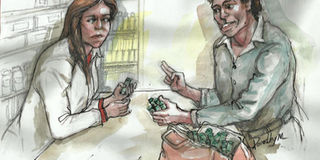How police broke up a drug ring

What you need to know:
For each patient, the doctor got a kickback of $1,500 and the pharmacy got $500. Imerovik got $1,000 as commission. In all, Imerovik sold about 2,780 fentanyl doses of the drug dispensed to him by the pharmacist. Court was later to estimate than more than 6,400 patches containing 100-micrograms of the drug were dispensed by the pharmacist.
In 2010, in Toronto Canada, Liridon Imerovick, in his early 20s, was prescribed a pain-killer, Percocet, for managing pain in his shoulders and back that started when he got involved in a car accident with his father. Percocet is a combination of the opiod oxycodone, and paracetamol and is used to treat moderate to severe short-term pain.
Sometime after his car accident, Imerovik was hired to do legitimate deliveries for a pharmacy. There was a medical clinic located in the pharmacy, where a doctor there was to prescribe to him a stronger pain-killer Oxycodone, an opioid, used for treatment of moderate to severe pain.
Imerovik, however, got addicted to the painkiller which also got him high. Eventually he began consuming fentanyl patches when he could no longer get high on Oxycodone alone. His main concern was having a constant supply of fentanyl for himself because of his addiction.
The drug fentanyl is a very powerful synthetic opioid used as a pain reliever. It is 50 to 100 times more potent than morphine and has been approved for treating severe pain, typically associated with cancer. It can be prescribed in the form of skin patches which, unfortunately, has been diverted for misuse and abuse.
An illegal turn
Apart from getting his own prescription of fentanyl, Imerovik began bringing patients or patient information to the doctor at the clinic who would then accordingly write out prescriptions of fentanyl that would be presented to the pharmacist for dispensing.
Imerovik and the pharmacist regularly communicated via text message about the deals. He would then collect the fentanyl and sell it to another dealer, Sean Holmes.
The arrangement was for the doctor to write prescriptions of the drug, of 30 doses for each of four patients per week. The pharmacist believed this number could go through the pharmacy without drawing attention to the scheme.
For each patient, the doctor got a kickback of $1,500 and the pharmacy got $500. Imerovik got $1,000 as commission. In all, Imerovik sold about 2,780 fentanyl doses of the drug dispensed to him by the pharmacist. Court was later to estimate than more than 6,400 patches containing 100-micrograms of the drug were dispensed by the pharmacist.
Pharmacist falters
The situation, however, soon began to get out of hand as the pharmacist became concerned about some of the younger patients that Imerovik was bringing in. The pharmacist knew the drug was bad and there were risks. As a result, the pharmacist started to restrict the number of new patients on the drug and started to dispense the drug to those she already knew.
In September 2015, about a month into the operation, the doctor and the pharmacist arranged to increase the number of prescriptions from four to six per week and this is when the police received information that a known drug trafficker, Sean Holmes, was travelling to that area to get his drug supply.
Surveillance
The police began conducting surveillance and on January 19, 2016 police officers observed Holmes and his girlfriend arriving at a hotel just after 11pm. They checked into a room on the third floor.
Shortly after, police saw Imerovik arrive and go to Holme’s room. He left carrying a floral gift bag which he had not carried before. As Imerovik drove away, police pulled him over and arrested him for dealing in a controlled substance.
The police recovered $31,905 in cash from the floral gift bag. They also found fentanyl prescription labels from the pharmacy in question as well as an envelope containing lists of names broken down by week. Each week had six names. All the patients on the list had been dispensed fentanyl from the pharmacy under investigation.
More drugs discovered
Police also carried out a search of Holme’s room and a total of 165 doses of the drug were seized, worth approximately $33,000. A search of Imerovik’s home address yielded another 88 doses of the drug, most of which were in a box with prescription labels attributed to the doctor in the clinic. More than $14,000 in cash was found in the bedroom closet.
In March 2016, police arrested the doctor and searched his office and car. The police found a number of patient labels in the trunk of the car. The names listed on the labels were all patients who had been dispensed fentanyl from the pharmacy. And during a search of the doctor’s bedroom, police found a sheet with lists of names, which corresponded to the fentanyl prescriptions dispensed by the pharmacist.
Two weeks later, the doctor, the pharmacist and others were charged with fentanyl trafficking and possession as part of the ring.
TO BE CONTINUED




